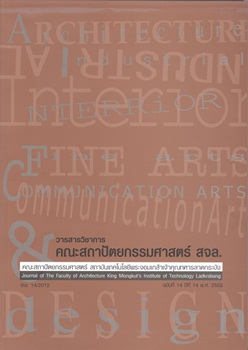การสำรวจทัศนคติและความต้องการของภาคธุรกิจเพื่อการพัฒนาหลักสูตรของสาขาการถ่ายภาพ กลุ่มวิชานิเทศศิลป์ สถาบันเทคโนโลยีพระจอมเกล้าเจ้าคุณทหารลาดกระบัง
Main Article Content
Abstract
บทคัดย่อ
หลักสูตรของสาขาการถ่ายภาพ กลุ่มวิชานิเทศศิลป์ สถาบันเทคโนโลยีพระจอมเกล้าเจ้าคุณทหารลาดกระบังจะถูกพัฒนาและนำไปใช้ในปีการศึกษา 2555 ดังนั้นงานวิจัยชิ้นนี้จึงต้องการสำรวจทัศนคติและความต้องการของผู้ประกอบการ บุคลากรทางสายอาชีพ ธุรกิจการถ่ายภาพ และศิษย์เก่าเพื่อพัฒนาปรับปรุงหลักสูตรให้ตรงกับความต้องการของตลาดและการเปลี่ยนแปลงของเทคโนโลยี โดยมีจุดประสงค์ คือ เพื่อทราบแบรนด์ของสาขาการถ่ายภาพ และเปรียบเทียบรายวิชาและหลักสูตรของสาขาการถ่ายภาพ กลุ่มวิชานิเทศศิลป์ สถาบันเทคโนโลยีพระจอมเกล้าเจ้าคุณทหารลาดกระบัง กับ Brooks Institute of Photography, USA โดยแบบสอบถามแบบออนไลน์ถูกส่งไปให้ศิษย์เก่าได้ตอบรับกลับมาจำนวน 45 ชุด และแบบสอบถามที่นำไปให้ธุรกิจทางการถ่ายภาพได้รับตอบกลับมา 225 ชุด และใช้โปรแกรม SPSS คำนวณค่าสถิติ โดยใช้ค่าร้อยละและค่าเฉลี่ย และผลการวิจัยสรุปได้ว่าแบรนด์ของสาขาการถ่ายภาพคือ “ทำงานร่วมกับผู้อื่นได้ดี พร้อมในการทำงานจริง มีทักษะทางเทคนิคและขยัน” ซึ่งถือเป็นจุดแข็งของหลักสูตรและนักศึกษาเช่นกัน และจุดอ่อนของนักศึกษา นั่นคือ “ตรงต่อเวลา ทักษะทางคอมพิวเตอร์ และธุรกิจ” และความสำคัญของรายวิชาจากมุมมองของบุคลากรสายอาชีพคือ ภาพถ่ายบุคคล, เทคนิคการนำเสนอ, แนวคิดของภาพถ่ายโฆษณา, มุมมองของอาร์ต ไดเร็กเตอร์, ภาพถ่ายแฟชั่น และภาพถ่ายหุ่นนิ่ง งานวิจัยชิ้นนี้เกิดประโยชน์ต่อการพัฒนาหลักสูตรเนื่องจากทำให้ทราบถึงแบรนด์และความต้องการของผู้บริโภคที่แท้จริง และเปรียบเทียบหลักสูตรสาขาการถ่ายภาพระหว่างประเทศไทยกับอเมริกา ซึ่งทำให้ทราบจุดแข็ง จุดอ่อนของหลักสูตรในปัจจุบัน เพื่อพัฒนาหลักสูตรการถ่ายภาพให้มีประสิทธิภาพมากยิ่งขึ้น
คำสำคัญ: การพัฒนาหลักสูตร, การถ่ายภาพ, แบรนด์
Abstract
The curriculum in Photography Program at the Communication Arts and Design Department, KMITL will be developed and launched a new course in 2012. Therefore, this paper investigates and Identifies attitudes and needs of business professional and alumni for curriculum development of photography program. The purpose of this study is to establish brand of Photography program and to identify and compare curriculum of KMITL to Brooks Institute of Photography, USA to develop curriculum for changing into digital technology. The online survey emailed to each alumni was returned back 45 responses and questionnaire for professional in
photography business was returned back 225. Consequently, the output from Statistical Package for Social Sciences or SPSS version 14 for Windows program was analyzed by using Frequency and Mean. As a result, Brand of photography program are “Teamwork, ready to work, technical skill, diligence” and these are the strengths of students and curriculum. Additionally, the weakness of students are “punctuality, computer and technology skill, business skill”. Lastly, the importance of course from professional’s view are People Photography, Presentation Technique, Advertising Photo Concepts, Art Director’s Point of View, Fashion Photography, and Still life Photography. Moreover, this research is one of the first studies that indentify brand of program, customer’s need and compare photography curriculum in Thailand and USA and highlight the strengths and weaknesses of the program to increase the efficiency of the program for future students.
Keywords: Curriculum development, photography, brand
Article Details
This work is licensed under a Creative Commons Attribution-NonCommercial-ShareAlike 4.0 International License.
Copyright Transfer Statement
The copyright of this article is transferred to Journal of The Faculty of Architecture King Mongkut's Institute of Technology Ladkrabang with effect if and when the article is accepted for publication. The copyright transfer covers the exclusive right to reproduce and distribute the article, including reprints, translations, photographic reproductions, electronic form (offline, online) or any other reproductions of similar nature.
The author warrants that this contribution is original and that he/she has full power to make this grant. The author signs for and accepts responsibility for releasing this material on behalf of any and all co-authors.


